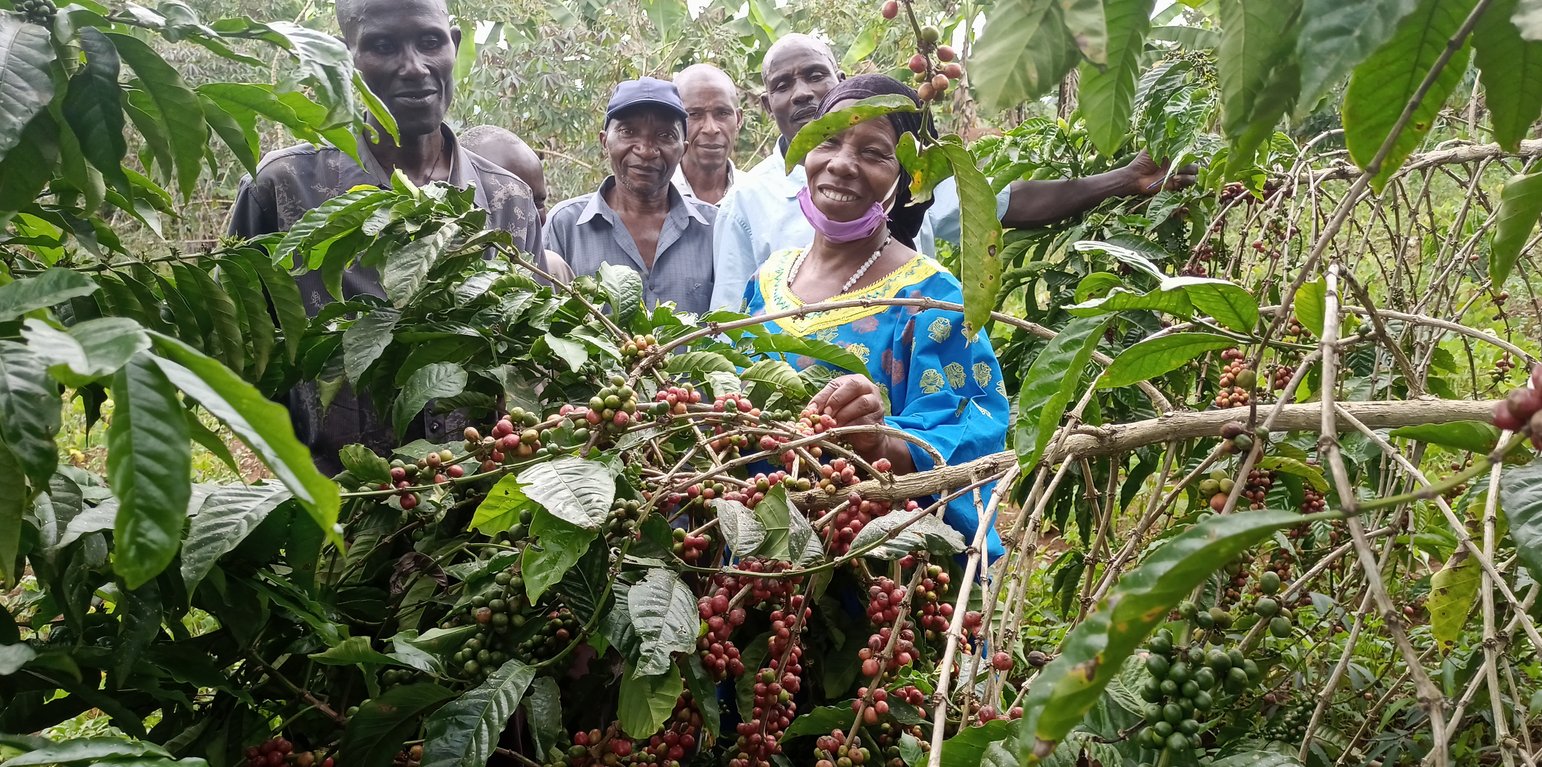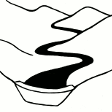Piggery-Banana-Coffee technology
(ອູເຈນດາ)
Obusa bwe mbizzi kumwanyi ne bitooke
ຄຳອະທິບາຍ
The "Piggery-Banana-Coffee" sustainable land management technology is a proven practice that significantly improves soil fertility and productivity in an integrated farming system for smallholder farmers in Uganda.
The “piggery-banana-coffee” SLM technology has been widely practiced by smallholders in Bukumansimbi District, Central Uganda for many years. The technology is proven due to its manifold functions and benefits, including increased productivity and improved soil biodiversity leading to better food security with organic, healthy produce. It simultaneously contributes to environmental protection. The technology has been applied for many years in Bukumansimbi but it needed a promotion by the implementer Caritas MADDO for wider adaption by the community.
The technology can be applied in a natural environmental setting with no controlled conditions. Taking a case of one acre (0.4 ha) of land the farmer will need 450 coffee seedlings and 150 banana suckers to establish an integrated banana-coffee plantation. Then there is a requirement for 10 pigs to supply enough manure (urine and dung) to maintain the fertility of the soil in the plantation. Bananas provide shade to the coffee and reduce the impact of wind and soil erosion. Manure from the piggery is applied to the mixed plantation. Manure application increases soil biodiversity and improves both the physical and chemical properties of the soil, including soil structure, aeration, and moisture retention. Integrating piggery components into the system requires shed construction, purchase of piglets, feeding costs, treatment, and vaccinations. The pigsty occupies a space of 50 ft by 25 ft (approx. 15 m x 7.5 m). Each enterprise is complementary to the other: manure from pigs goes to the coffee and banana plantation and in return the banana peelings as well as the household food leftovers are served as important food resources for the pigs.
The land users under the pilot project acknowledge the significance of the technology because of its ability to sustain production and the other benefits listen above. However, swine fever disease is one of the limiting factors to the technology, as the pigs are prone to its outbreak. Moreover, some farmers report the high feeding costs for the pigs’ maintenance - particularly in the dry season (when there are few weeds that can be supplemented to the diet of the pigs).
ສະຖານທີ່
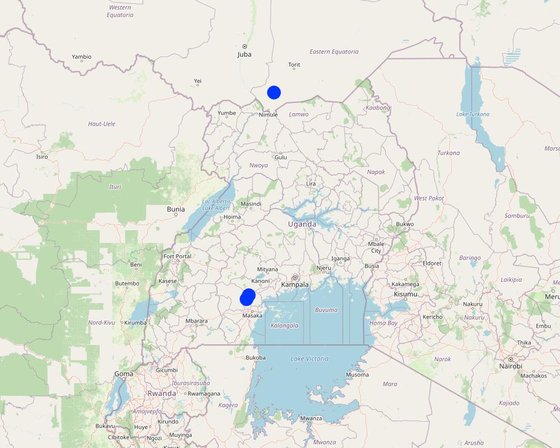
ສະຖານທີ່: Bigasa Sub County in Bukomansimbi District, Central region, ອູເຈນດາ
ຈໍານວນ ພື້ນທີ່ ທີ່ໃຊ້ ເຕັກໂນໂລຢີ ທີ່ໄດ້ວິເຄາະ: 10-100 ພຶ້ນທີ່
ການຄັດເລືອກພື້ນທີ່ ທີ່ອີງໃສ່ຂໍ້ມູນທາງພູມີສາດ
-
32.16797, 3.94827
-
31.62506, -0.09484
-
31.66738, -0.02196
ການແຜ່ກະຈາຍຂອງເຕັກໂນໂລຢີ: ແຜ່ຂະຫຍາຍຢ່າງໄວວາໃນພື້ນທີ່ (approx. 0.1-1 ກມ 2)
ຢູ່ໃນເຂດປ່າສະຫງວນທີ່ບໍ?: ບໍ່ແມ່ນ
ວັນທີຂອງການປະຕິບັດ: 2017; ຕໍ່າກວ່າ 10 ປີ ຜ່ານມາ (ມາເຖິງປະຈຸບັນ)
ປະເພດຂອງການນໍາສະເໜີ
-
ໂດຍຜ່ານນະວັດຕະກໍາຄິດຄົ້ນຂອງຜູ້ນໍາໃຊ້ທີ່ດິນ
-
ເປັນສ່ວນໜື່ງຂອງລະບົບພື້ນເມືອງ (>50 ປີ)
-
ໃນໄລຍະການທົດລອງ / ການຄົ້ນຄວ້າ
-
ໂດຍຜ່ານໂຄງການ / ການຊ່ວຍເຫຼືອຈາກພາຍນອກ
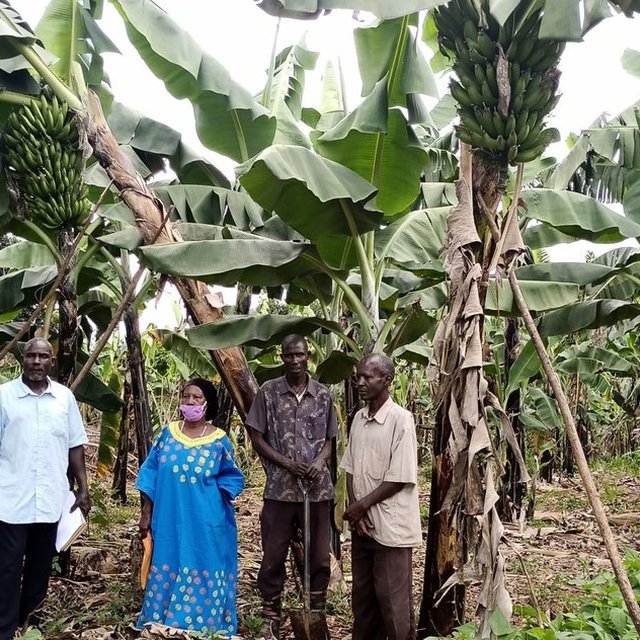
Participants in the banana plantation (Nabukenya, Beatrice)
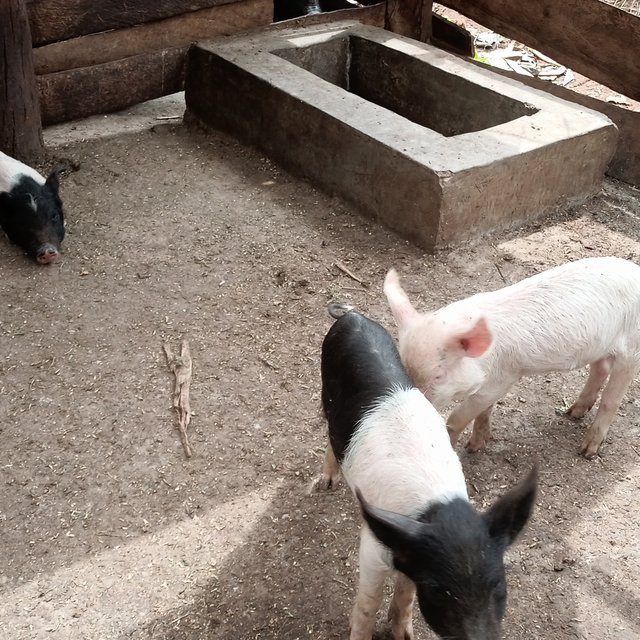
Piglets in a newly established piggery (Nabukenya, Beatrice)
ຈຸດປະສົງຕົ້ນຕໍ
-
ປັບປຸງ ການຜະລິດ
-
ຫຼຸດຜ່ອນ, ປ້ອງກັນ, ຟື້ນຟູ ການເຊື່ອມໂຊມຂອງດິນ
-
ການອະນຸລັກ ລະບົບນິເວດ
-
ປົກປັກຮັກສານໍ້າ / ນໍ້າພື້ນທີ່ - ປະສົມປະສານກັບ ເຕັກໂນໂລຢີອື່ນໆ
-
ປົກປັກຮັກສາ / ການປັບປຸງຊີວະນາໆພັນ
-
ຫຼຸດຜ່ອນຄວາມສ່ຽງ ທາງໄພພິບັດທໍາມະຊາດ
-
ປັບຕົວຕໍ່ກັບການປ່ຽນແປງດິນຟ້າອາກາດ / ທີ່ຮ້າຍແຮງ ແລະ ຜົນກະທົບ
-
ຫຼຸດຜ່ອນຜົນກະທົບ ຈາກການປ່ຽນແປງດິນຟ້າອາກາດ
-
ສ້າງຜົນກະທົບ ທາງເສດຖະກິດ ທີ່ເປັນປະໂຫຍດ
-
ສ້າງຜົນກະທົບ ທີ່ເປັນທາງບວກ ໃຫ້ແກ່ສັງຄົມ
ການນໍາໃຊ້ດິນ
ການນຳໃຊ້ທີ່ດິນ ປະສົມພາຍໃນພື້ນທີ່ດຽວກັນ: ແມ່ນ - ກະສິກໍາ-ປ່າໄມ້ ແບບປະສົມປະສານ
-
ດິນທີ່ປູກພືດ
- ພືດຢືນຕົ້ນ (ບໍ່ແມ່ນໄມ້): ກ້ວຍ/ກວ້ຍຂຽວ/ໄຍຕົ້ນກ້ວຍ, Coffee
ຈໍານວນ ລະດູການ ປູກໃນປີໜຶ່ງ: 2
ມີການເຝືກປູກພືດແບບສັບຫວ່າງບໍ່? ແມ່ນ
ມີການເຝືກປູກພືດແບບໝູນວຽນບໍ່? ບໍ່ແມ່ນ
-
ປ່າໄມ້ / ປ່າ
- ການປູກຕົ້ນໄມ້, ການປູກປ່າ. ແນວພັນ: ແນວພັນປະສົມ
Tree types (ປ່າດົງດິບ): n.a.
ຜົນຜະລິດ ແລະ ການບໍລິການ: ເຄື່ອງປ່າຂອງດົງ, ໄມ້ຟືນ, ຜະລິດຕະພັນ ປ່າໄມ້ອື່ນໆ, ທົ່ງຫຍ້າ, ການອະນຸລັກທໍາມະຊາດ / ການປ້ອງກັນ, ນັນທະນາການ / ການທ່ອງທ່ຽວ, ປ້ອງກັນ ການຄຸກຄາມ ທາງທໍາມະຊາດ, Backcloth
-
ທິດທາງໄຫຼຂອງນໍ້າ, ນໍ້າ, ດິນທາມ - ໜອງ, ດິນທາມ
ຜະລິດຕະພັນຫຼັກ / ບໍລິການ: Swamp is nearby for water supply
ການສະໜອງນໍ້າ
-
ນໍ້າຝົນ
-
ປະສົມປະສານ ກັນລະຫວ່າງ ນໍ້າຝົນ ແລະ ນໍ້າຊົນລະປະທານ
-
ນໍາໃຊ້ ນໍ້າຊົນລະປະທານ ພຽງຢ່າງດຽວ
ຈຸດປະສົງທີ່ກ່ຽວຂ້ອງກັບການເຊື່ອມໂຊມຂອງດິນ
-
ປ້ອງກັນການເຊື່ອມໂຊມຂອງດິນ
-
ຫຼຸດຜ່ອນການເຊື່ອມໂຊມຂອງດິນ
-
ການຟື້ນຟູ / ຟື້ນຟູດິນທີ່ຊຸດໂຊມ
-
ປັບຕົວຕໍ່ການເຊື່ອມໂຊມຂອງດິນ
-
ບໍ່ສາມາດໃຊ້ໄດ້
ການເຊື່ອມໂຊມ ທີ່ຕ້ອງໄດ້ເອົາໃຈໃສ່
-
ດິນເຊາະເຈື່ອນ ໂດຍນໍ້າ - Wt: ການສູນເສຍຊັ້ນໜ້າດິນ / ການເຊາະເຈື່ອນຜິວໜ້າດິນ, Wo: ຜົນກະທົບ ຂອງການເຊື່ອມໂຊມ ຕໍ່ພື້ນທີ່ພາຍນອກ
-
ການເຊື່ອມໂຊມ ຂອງດິນ ທາງເຄມີ - Cp: ດິນເປັນມົນລະພິດ
-
ການເຊື່ອມໂຊມ ທາງຊີວະພາບ - Bq: ປະລິມານ / ອິນຊີວັດຖຸຫຼຸດລົງ, Bs: ຄຸນນະພາບ / ການອັດແໜ້ນ ຂອງສາຍພັນຫຼຸດລົງ, Bl: ການສູນເສຍ ຈຸລິນຊີໃນດິນ, Bp: ສັດຕູພືດ ແລະ ພະຍາດເພີ່ມຂື້ນ, ສູນເສຍນັກລ່າ ແມງໄມ້ທີ່ໃຊ້ປາບສັດຕູພືດ ແລະ ພະຍາດຂອງພືດ
-
ການເຊື່ອມໂຊມ ຂອງນໍ້າ - Hq: ຄຸນນະພາບ ຂອງນ້ຳໃຕ້ດິນຫຼຸດລົງ
ກຸ່ມການຄຸ້ມຄອງທີ່ດິນແບບຍືນຍົງ
-
ກະສິກໍາ-ປ່າໄມ້ ແບບປະສົມປະສານ
-
ການຄຸ້ມຄອງພືດ ແລະ ລ້ຽງສັດ ແບບປະສົມປະສານ
-
ການຈັດການອຸດົມສົມບູນ ຂອງດິນປະສົມປະສານ
ມາດຕະການ ການຄຸ້ມຄອງທີ່ດິນແບບຍືນຍົງ
-
ມາດຕະການ ທາງການກະສິກໍາ - A1: ພືດ / ການປົກຫຸ້ມຂອງດິນ, A2: ອິນຊີວັດຖຸ ຫຼື ຄວາມອຸດົມສົມບູນໃນດິນ , A3: ການບໍາລຸງຮັກສາຊັ້ນໜ້າດິນ (A 3.2: Reduced tillage (> 30% soil cover)), A7: ອື່ນໆ
-
ມາດຕະການ ທາງດ້ານພືດພັນ - V1: ເປັນໄມ້ຢືນຕົ້ນ ແລະ ການປົກຫຸ້ມຂອງໄມ້ພຸ່ມ, V2: ຫຍ້າ ແລະ ພືດສະໝູນໄພທີ່ເປັນໄມ້ຢືນຕົ້ນ , V3: ການຈັດການປູກພືດ
-
ມາດຕະການໂຄງສ້າງ - S1: ພັກຄັນໃດ, S9: ແນວບັງພືດ ແລະ ສັດລ້ຽງ
ເທັກນິກການແຕ້ມຮູບ
ຂໍກຳນົດທາງເທັກນິກ
Technical specifications of the pig sty construction
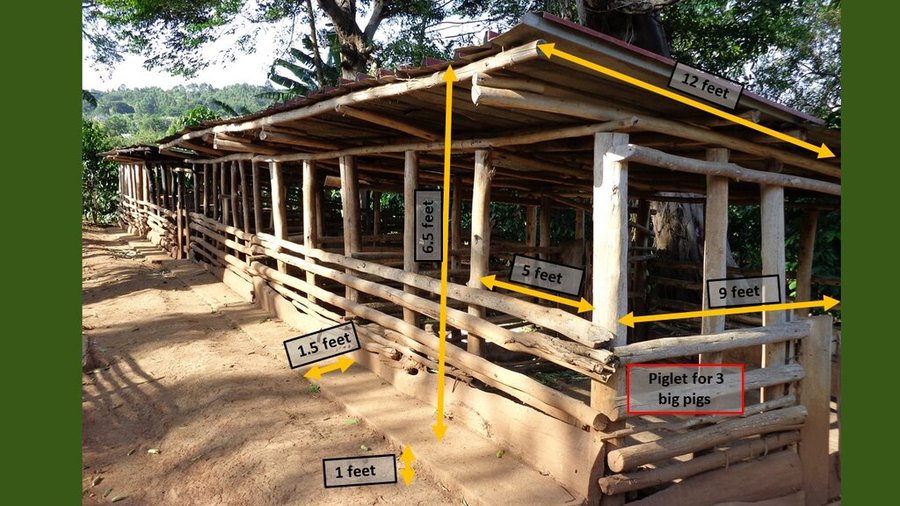
Author: Kyambadde, Tonny
Technical specifications of the coffee and banana integration
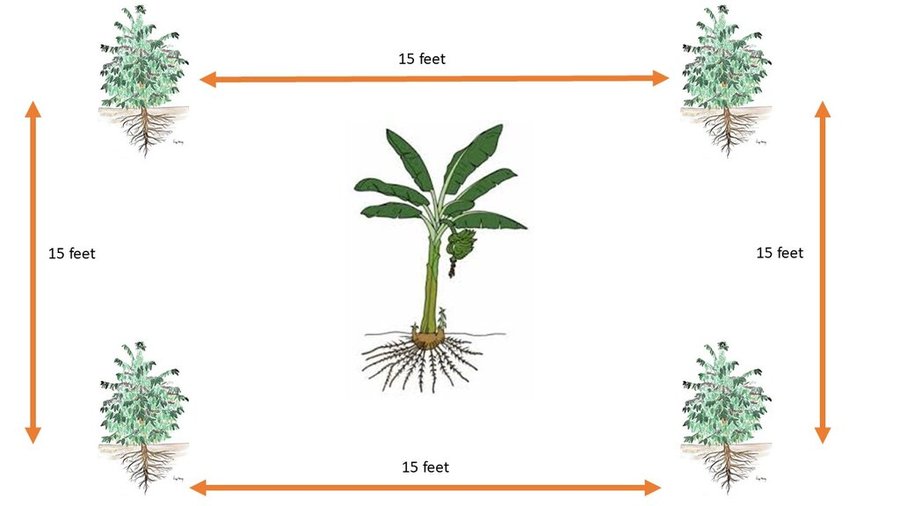
Author: Kyambadde, Tonny
ການຈັດຕັ້ງ ແລະ ບໍາລຸງຮັກສາ: ກິດຈະກໍາ, ວັດຖຸດິບ ແລະ ຄ່າໃຊ້ຈ່າຍ
ການຄຳນວນ ປັດໃຈການຜະລິດ ແລະ ຄ່າໃຊ້ຈ່າຍ
- ຄິດໄລ່ຄ່າໃຊ້ຈ່າຍ: ຕໍ່ພື້ນທີ່ ທີ່ໄດ້ຈັດຕັ້ງປະຕິບັດ ເຕັກໂນໂລຢີ (ຂະໜາດ ແລະ ຫົວໜ່ວຍ ຂອງພື້ນທີ່:one hectare)
- ສະກຸນເງິນທີ່ໃຊ້ສໍາລັບການຄິດໄລ່ຄ່າໃຊ້ຈ່າຍ: Uganda Shilling
- ອັດຕາແລກປ່ຽນ (ເປັນເງີນ ໂດລາ): 1 USD = 3750.0 Uganda Shilling
- ຄ່າແຮງງານສະເລ່ຍ ຂອງການຈ້າງແຮງງານຕໍ່ມື້: no labour was hired
ປັດໄຈທີ່ສໍາຄັນສຸດທີ່ສົ່ງຜົນກະທົບຕໍ່ຄ່າໃຊ້ຈ່າຍ
Most costs are connected to the piggery in particular the maintenance of the pigs. Animal diseases and the resulting costs for the treatments are unplanned expenses.
ກິດຈະກໍາການສ້າງຕັ້ງ
-
Land clearing and preparation (ໄລຍະເວລາ / ຄວາມຖີ່: once a year)
-
Hole digging (ໄລຍະເວລາ / ຄວາມຖີ່: once)
-
Coffee and banana planting (ໄລຍະເວລາ / ຄວາມຖີ່: once)
-
Pig sty (house) construction (ໄລຍະເວລາ / ຄວາມຖີ່: once)
-
Purchase of pigs (ໄລຍະເວລາ / ຄວາມຖີ່: once)
ຕົ້ນທຶນທັງໝົດ ໃນການຈັດຕັ້ງປະຕິບັດ (ໂດຍການປະມານ)
5300000.0
ກິດຈະກໍາບໍາລຸງຮັກສາ
-
Weeding and garden clearing (ໄລຍະເວລາ / ຄວາມຖີ່: Twice a seaon)
-
Manure application (ໄລຍະເວລາ / ຄວາມຖີ່: At the onset of rain season)
-
Feeding and watering of pigs (ໄລຍະເວລາ / ຄວາມຖີ່: On daily basis)
-
Treatment and deworming of pigs (ໄລຍະເວລາ / ຄວາມຖີ່: On monthly basis)
-
Mulching of the garden (ໄລຍະເວລາ / ຄວາມຖີ່: Once a year or more)
-
Contour digging (ໄລຍະເວລາ / ຄວາມຖີ່: once a year)
-
Pruning of coffee and banana plantation (ໄລຍະເວລາ / ຄວາມຖີ່: For banana its done twice a season and for coffee its done every after harvesting season.)
-
Maintenance of piggery sty (ໄລຍະເວລາ / ຄວາມຖີ່: once a year)
ຕົ້ນທຶນທັງໝົດ ໃນການບໍາລຸງຮັກສາ (ໂດຍການປະມານ)
500000.0
ສະພາບແວດລ້ອມທໍາມະຊາດ
ສະເລ່ຍປະລິມານນໍ້າຝົນປະຈໍາປີ
-
< 250 ມີລິແມັດ
-
251-500 ມີລິແມັດ
-
501-750 ມີລິແມັດ
-
751-1,000 ມີລິແມັດ
-
1,001-1,500 ມີລິແມັດ
-
1,501-2,000 ມີລິແມັດ
-
2,001-3,000 ມີລິແມັດ
-
3,001-4,000 ມີລິແມັດ
-
> 4,000 ມີລິແມັດ
ເຂດກະສິກໍາ-ສະພາບອາກາດ
-
ຄວາມຊຸ່ມ
-
ເຄີ່ງຄວາມຊຸ່ມ
-
ເຄິ່ງແຫ້ງແລ້ງ
-
ແຫ້ງແລ້ງ
ຂໍ້ມູນຈໍາເພາະກ່ຽວກັບສະພາບອາກາດ
ປະລິມານນໍ້າຝົນສະເລ່ຍຕໍ່ປີເປັນມິລິແມັດ: 1200.0
The rainfall pattern is bimodal, having two seasons. The two dry spell seasons are between January - March and between June to August, with the winter seasons between March to May and September to December.
ຊື່ຂອງສະຖານີອຸຕຸນິຍົມ: Uganda metrological authority
The average maximum temperature doesn't exceed 30 degrees Celcius and the minimum temperature is not below 10 degrees Celcius with almost equal length of the day and night through out the year.
The humidity level is relatively low through out the area.
ຄວາມຄ້ອຍຊັນ
-
ພື້ນທີ່ຮາບພຽງ (0-2%)
-
ອ່ອນ (3-5 %)
-
ປານກາງ (6-10 %)
-
ມ້ວນ (11-15 %)
-
ເນີນ(16-30%)
-
ໍຊັນ (31-60%)
-
ຊັນຫຼາຍ (>60%)
ຮູບແບບຂອງດິນ
-
ພູພຽງ / ທົ່ງພຽງ
-
ສັນພູ
-
ເປີ້ນພູ
-
ເນີນພູ
-
ຕີນພູ
-
ຮ່ອມພູ
ລະດັບຄວາມສູງ
-
0-100 ແມັດ a.s.l.
-
101-500 ແມັດ a.s.l.
-
501-1,000 ແມັດ a.s.l.
-
1,001-1,500 ແມັດ a.s.l.
-
1,501-2,000 ແມັດ a.s.l.
-
2,001-2,500 ແມັດ a.s.l.
-
2,501-3,000 ແມັດ a.s.l.
-
3,001-4,000 ແມັດ a.s.l.
-
> 4,000 ແມັດ a.s.l.
ເຕັກໂນໂລຢີໄດ້ຖືກນໍາໃຊ້ໃນ
-
ລັກສະນະສວດ
-
ລັກສະນະກີ່ວ
-
ບໍ່ກ່ຽວຂ້ອງ
ຄວາມເລິກຂອງດິນ
-
ຕື້ນຫຼາຍ (0-20 ຊັງຕີແມັດ)
-
ຕື້ນ (21-50 ຊຕມ)
-
ເລີກປານກາງ (51-80 ຊຕມ)
-
ເລິກ (81-120 ຊມ)
-
ເລິກຫຼາຍ (> 120 cm)
ໂຄງສ້າງຂອງດິນ (ເທີງໜ້າດິນ)
-
ຫຍາບ / ເບົາ (ດິນຊາຍ)
-
ປານກາງ (ດິນໜຽວ, ດິນໂຄນ)
-
ບາງລະອຽດ / ໜັກ (ໜຽວ)
ໂຄງສ້າງຂອງດິນ (ເລິກລົງ 20 ຊັງຕີແມັດ)
-
ຫຍາບ / ເບົາ (ດິນຊາຍ)
-
ປານກາງ (ດິນໜຽວ, ດິນໂຄນ)
-
ບາງລະອຽດ / ໜັກ (ໜຽວ)
ທາດອິນຊີຢູ່ເທິງໜ້າດິນ
-
ສູງ (> 3 %)
-
ປານກາງ (1-3 %)
-
ຕໍາ່ (<1 %)
ນ້ຳໃຕ້ດິນ
-
ເທິງຊັ້ນໜ້າດິນ
-
< 5 ແມັດ
-
5-50 ແມັດ
-
> 50 ແມັດ
ມີນໍ້າໜ້າດິນ
-
ເກີນ
-
ດີ
-
ປານກາງ
-
ທຸກຍາກ / ບໍ່ມີ
ຄຸນນະພາບນໍ້າ (ການຮັກສາ)
-
ມີນໍ້າດື່ມ
-
ບໍ່ມີນໍ້າດື່ມ (ຮຽກຮ້ອງໃຫ້ມີການບຳບັດນ້ຳ)
-
ນຳໃຊ້ເຂົ້າໃນການຜະລິດກະສິກໍາພຽງຢ່າງດຽງ (ຊົນລະປະທານ)
-
ຜິດປົກກະຕິ
ຄຸນນະພາບນ້ຳ ໝາຍເຖີງ: ທັງນ້ຳໃຕ້ດິນ ແລະ ນ້ຳໜ້າດິນ
ດິນເຄັມເປັນບັນຫາບໍ່?
ການເກີດນໍ້າຖ້ວມ
ຄວາມຫຼາກຫຼາຍຂອງສິ່ງທີ່ມີຊີວິດ
ຄຸນລັກສະນະຂອງຜູ້ນຳໃຊ້ທີ່ດິນການນໍາໃຊ້ເຕັກໂນໂລຢີ
ການວາງແນວທາງຕະຫຼາດ
-
ກຸ້ມຕົນເອງ (ພໍພຽງ)
-
ປະສົມປົນເປ( ກຸ້ມຕົນເອງ/ເປັນສິນຄ້າ)
-
ການຄ້າ / ຕະຫຼາດ
ລາຍຮັບທີ່ໄດ້ມາຈາກກິດຈະກໍາອື່ນໆ ທີ່ບໍ່ແມ່ນການຜະລິດກະສິກໍາ
-
ໜ້ອຍກ່ວາ 10 % ຂອງລາຍຮັບທັງໝົດ
-
10-50 % ຂອງລາຍຮັບທັງໝົດ
-
> 50 % ຂອງລາຍຮັບທັງໝົດ
ລະດັບຄວາມຮັ່ງມີ
-
ທຸກຍາກຫຼາຍ
-
ທຸກຍາກ
-
ສະເລ່ຍ
-
ຮັ່ງມີ
-
ຮັ່ງມີຫຼາຍ
ລະດັບຂອງການຫັນເປັນກົນຈັກ
-
ການໃຊ້ແຮງງານຄົນ
-
ສັດລາກແກ່
-
ເຄື່ອງກົນຈັກ
ຢູ່ປະຈຳ ຫຼື ເລລ້ອນ
-
ບໍ່ເຄື່ອນໄຫວ
-
ແບບເຄີ່ງຂັງ-ເຄີ່ງປ່ອຍ
-
ແບບປ່ອຍຕາມທຳມະຊາດ
ບຸກຄົນ ຫຼື ກຸ່ມ
-
ບຸກຄົນ / ຄົວເຮືອນ
-
ກຸ່ມ / ຊຸມຊົນ
-
ການຮ່ວມມື
-
ການຈ້າງງານ (ບໍລິສັດ, ອົງການ ລັດຖະບານ)
ອາຍຸ
-
ເດັກນ້ອຍ
-
ຊາວໜຸ່ມ
-
ໄວກາງຄົນ
-
ຜູ້ສູງອາຍຸ
ເຂດພື້ນທີ່ການນໍາໃຊ້ຕໍ່ຄົວເຮືອນ
-
<0.5 ເຮັກຕາ
-
0.5-1 ເຮັກຕາ
-
1-2 ເຮັກຕາ
-
2-5 ເຮັກຕາ
-
5-15 ເຮັກຕາ
-
15-50 ເຮັກຕາ
-
50-100 ເຮັກຕາ
-
100-500 ເຮັກຕາ
-
500-1,000 ເຮັກຕາ
-
1,000-10,000 ເຮັກຕາ
-
> 10,000 ເຮັກຕາ
ຂະໜາດ
-
ຂະໜາດນ້ອຍ
-
ຂະໜາດກາງ
-
ຂະໜາດໃຫຍ່
ເຈົ້າຂອງທີ່ດິນ
-
ລັດ
-
ບໍລິສັດ
-
ຊຸມຊົນ / ບ້ານ
-
ກຸ່ມ
-
ບຸກຄົນ, ບໍ່ມີຕໍາແໜ່ງ
-
ບຸກຄົນ, ທີ່ມີຕໍາແໜ່ງ
ສິດທິການນໍາໃຊ້ທີ່ດິນ
-
ເປີດກວ້າງ (ບໍ່ມີການຈັດຕັ້ງ)
-
ຊຸມຊົນ (ທີ່ມີການຈັດຕັ້ງ)
-
ເຊົ່າ
-
ບຸກຄົນ
ສິດທິການນໍາໃຊ້ນໍ້າ
-
ເປີດກວ້າງ (ບໍ່ມີການຈັດຕັ້ງ)
-
ຊຸມຊົນ (ທີ່ມີການຈັດຕັ້ງ)
-
ເຊົ່າ
-
ບຸກຄົນ
ການເຂົ້າເຖິງການບໍລິການ ແລະ ພື້ນຖານໂຄງລ່າງ
ການຈ້າງງານ (ຕົວຢ່າງ, ການເຮັດກິດຈະກໍາອື່ນ ທີ່ບໍ່ແມ່ນ ການຜະລິດກະສິກໍາ)
ຖະໜົນຫົນທາງ ແລະ ການຂົນສົ່ງ
ການດື່ມນໍ້າ ແລະ ສຸຂາພິບານ
ການບໍລິການ ທາງດ້ານການເງິນ
ຜົນກະທົບ
ຜົນກະທົບທາງສັງຄົມ ແລະ ເສດຖະກິດ
ຜົນຜະລິດ
ປະລິມານ ກ່ອນການຈັດຕັ້ງປະຕິບັດ ການຄຸ້ມຄອງ ທີ່ດິນແບບຍືນຍົງ: 1
ປະລີມານ ຫຼັງການຈັດຕັ້ງປະຕິບັດ ການຄຸ້ມຄອງ ທີ່ດິນແບບຍືນຍົງ: 3
Significant improvement in coffee production was noticed jumping from an average yield increase of 300kg to 700kg of coffee harvest in one acre per season. Size of banana bunches with an average increase in weight from from 12kg to 30kg.
ຄຸນນະພາບຂອງພືດ
ປະລິມານ ກ່ອນການຈັດຕັ້ງປະຕິບັດ ການຄຸ້ມຄອງ ທີ່ດິນແບບຍືນຍົງ: 0
ປະລີມານ ຫຼັງການຈັດຕັ້ງປະຕິບັດ ການຄຸ້ມຄອງ ທີ່ດິນແບບຍືນຍົງ: 2
Coffee beans improved a lot in terms of size and quality, with over 70% coffee beans harvested in the category of screen 18 (super beans). The banana size and its fingers improved in size, and the taste of banana food greatly improve with a pleasant aroma, softer on eating and cooks faster compared to previously produced bananas.
ຜົນຜະລິດຂອງສັດ
The production of pigs increased substantially in a time period of a year. The participating farmers started with 3 pigs at the beginning and reached an increase of pigs to an average 15 pigs after a year (2 breeding cycles per pig per year).
ການຈັດການຄຸ້ມຄອງທີ່ດິນ
ປະລິມານ ກ່ອນການຈັດຕັ້ງປະຕິບັດ ການຄຸ້ມຄອງ ທີ່ດິນແບບຍືນຍົງ: -2
ປະລີມານ ຫຼັງການຈັດຕັ້ງປະຕິບັດ ການຄຸ້ມຄອງ ທີ່ດິນແບບຍືນຍົງ: 3
The farming system employed by the farmers previously before introduction of the technology was not sustainable. Resources were being continuously depleted by crop practices employed without replacement of what is lost from the soil during harvest. integration of piggery into the system improved soil fertility with manure composted from piggery wastes. Besides boosting soil fertility, biodiversity on the farm improved as well (the soil organisms, new plant species emerged, insect species among others) the green biomass and overall soil health improved.
ລາຍຮັບ ຈາກການຜະລີດ
The average farm income before the technology was very little and did not support the family's basic home needs. With the introduction of the technology, the household income improved from an average of monthly 45.000 UGX to 150.000 UGX. However, it is important to note that this is not a fixed monthly income and is depending on the harvest season. Thus, there are peak income phases followed by low seasons.
ຄວາມຫຼາກຫຼາຍ ຂອງແຫຼ່ງລາຍຮັບ
More income sources were established through the three enterprises (coffee, banana and piggery).
ຜົນກະທົບທາງສັງຄົມ ວັດທະນະທໍາ
ການຄໍ້າປະກັນ ສະບຽງອາຫານ / ກຸ້ມຢູ່ກຸ້ມກິນ
ປະລິມານ ກ່ອນການຈັດຕັ້ງປະຕິບັດ ການຄຸ້ມຄອງ ທີ່ດິນແບບຍືນຍົງ: 0
ປະລີມານ ຫຼັງການຈັດຕັ້ງປະຕິບັດ ການຄຸ້ມຄອງ ທີ່ດິນແບບຍືນຍົງ: 2
With improved soil fertility resulting in bigger sizes of banana bunches, improved food security was achieved. The increased income from coffee and piggery ensured availability of alternative food supply though their sale.
ຄວາມຮູ້ກ່ຽວກັບ ການຄຸ້ມຄອງ ທີ່ດິນແບບຍືນຍົງ / ການເຊື່ອມໂຊມຂອງດິນ
Through the technology farmers were able to learn how important it is to use organic sources of fertilizer and its benefits to the environment and soil health. MADDO facilitated roughly 15 different training sessions for the participating farmer group targeting the soil and water conservation practices.
ສະຖານະພາບ ທາງສັງຄົມ ແລະ ຄວາມດ້ອຍໂອກາດ ທາງເສດຖະກິດ (ເພດ, ອາຍຸ, ສະຖານະພາບ, ຊົນເຜົ່າ ແລະ ອື່ນໆ)
The situation of women (average between 40-55 years old) was improved through the technology by giving them access and knowledge to this pilot project. The mobilization and right selection of participants were crucial for the improvement.
ຜົນກະທົບຕໍ່ລະບົບນິເວດ
ຄວາມຊຸ່ມຂອງດິນ
Higher retention of soil moisture
ອິນຊີວັດຖຸໃນດິນ / ຢູ່ລຸ່ມຊັ້ນດິນ C
Better composition of soil nutrients with increased population of soil organisms (micro and macro)
ມວນຊີວະພາບ / ຢູ່ເທິງຊັ້ນດິນ C
ຄວາມຫຼາກຫຼາຍ ທາງດ້ານທີ່ຢູ່ອາໃສ ຂອງສິ່ງທີ່ມີຊີວິດ
Organic manure provided a conducive environment for multiplication and survival of living organisms
ຜົນກະທົບນອກສະຖານທີ່
Pollution of water
The usage of organic manure instead of chemical fertilizers reduced the pollution of downstream water from fields
ການວິເຄາະຕົ້ນທຶນ ແລະ ຜົນປະໂຫຍດ
ຜົນປະໂຫຍດເມື່ອທຽບກັບຄ່າໃຊ້ຈ່າຍໃນການສ້າງຕັ້ງ
ຜົນຕອບແທນ ໃນໄລຍະສັ້ນ
ຜົນກະທົບທາງລົບຫຼາຍ
ຜົນກະທົບທາງບວກຫຼາຍ
ຜົນຕອບແທນ ໃນໄລຍະຍາວ
ຜົນກະທົບທາງລົບຫຼາຍ
ຜົນກະທົບທາງບວກຫຼາຍ
ຜົນປະໂຫຍດເມື່ອທຽບກັບຄ່າໃຊ້ຈ່າຍບໍາລຸງຮັກສາ
ຜົນຕອບແທນ ໃນໄລຍະສັ້ນ
ຜົນກະທົບທາງລົບຫຼາຍ
ຜົນກະທົບທາງບວກຫຼາຍ
ຜົນຕອບແທນ ໃນໄລຍະຍາວ
ຜົນກະທົບທາງລົບຫຼາຍ
ຜົນກະທົບທາງບວກຫຼາຍ
ການປ່ຽນແປງສະພາບດິນຟ້າອາກາດ
-
ການຍອມຮັບ ແລະ ການປັບຕົວ
ອັດຕາສ່ວນຂອງຜູ້ຊົມໃຊ້ທີ່ດິນໃນເຂດພື້ນທີ່ທີ່ໄດ້ຮັບຮອງເອົາເຕັກໂນໂລຢີ
-
ກໍລະນີດຽວ / ການທົດລອງ
-
1-10%
-
11-50%
-
> 50%
ທັງໝົດນັ້ນ ມີໃຜແດ່ທີ່ສາມາດປັບຕົວຕໍ່ເຕັກໂນໂລຢີ, ມີຈັກຄົນທີ່ໄດ້ຮັບການກະຕຸກຊຸກຍູ້ ແລະ ອຸປະກອນ?
-
0-10%
-
11-50%
-
51-90%
-
91-100%
ຈໍານວນຄົວເຮືອນ ແລະ / ຫຼືບໍລິເວນກວມເອົາ
Mainstreaming of the technology was promoted through copying from the participants and also due to the promotion by the district field staff. The technology has been in existence for years and that is why a high adoption can be observed.
ໄດ້ມີການດັດແປງເຕັກໂນໂລຢີ ເພື່ອປັບໃຫ້ເຂົ້າກັບເງື່ອນໄຂການປ່ຽນແປງບໍ່?
ໄດ້ປ່ຽນແປງເງື່ອນໄຂຫຍັງແດ່?
-
ການປ່ຽນແປງດິນຟ້າອາກາດ / ຮ້າຍແຮງ
-
ຕະຫຼາດມີການປ່ຽນແປງ
-
ມີແຮງງານ (ຕົວຢ່າງ, ເນື່ອງຈາກການເຄື່ອນຍ້າຍແຮງງານ)
ບົດສະຫຼຸບ ແລະ ບົດຮຽນທີ່ໄດ້ຮັບ
ຄວາມເຂັ້ມແຂງ: ທັດສະນະມູມມອງ ຂອງຜູ້ນໍາໃຊ້ທີ່ດິນ
-
Contributes positively to the soil fertility.
-
Improves the food security and household income
ຄວາມເຂັ້ມແຂງ: ທັດສະນະມຸມມອງ ຂອງຜູ້ປ້ອນຂໍ້ມູນເອງ
-
Farmers were able to local available resources for this technology.
-
It improved the soil health and contributed to environmental conservation.
ຈຸດອ່ອນ / ຂໍ້ເສຍ / ຄວາມສ່ຽງ: ທັດສະນະມູມມອງ ຂອງຜູ້ນໍາໃຊ້ທີ່ດິນວິທີການແກ້ໄຂແນວໃດ
-
Diseases that affect the piggery (swine fewer).
No mitigation (vaccination) available.
-
The vet officers are not always available for vaccinations or treatments for the pigs. Moreover, there are quite expensive.
Farmers group together to lobby for the service.
ຈຸດອ່ອນ / ຂໍ້ເສຍ / ຄວາມສ່ຽງ: ທັດສະນະມຸມມອງ ຂອງຜູ້ປ້ອນຂໍ້ມູນເອງວິທີການແກ້ໄຂແນວໃດ
-
Follow up on the management practices for the piggery were time consuming.
Establishment of community-based trainers (CBT) that take over
ເອກກະສານອ້າງອີງ
Editors
-
Beatrice Nabukenya
-
Michael Mulindwa
-
Kyagaba Prossy
-
Annika Reimann
ການທົບທວນຄືນ
-
William Critchley
-
Rima Mekdaschi Studer
ວັນທີຂອງການປະຕິບັດ: May 18, 2021
ປັບປຸງລ່າສຸດ: Nov. 16, 2023
ບຸກຄົນທີ່ສໍາຄັນ
-
Tonny Kyambadde - co-compiler
-
Prossy Kyagaba - co-compiler
-
Beatrice Nabukenya - co-compiler
-
Michael Mulindwa - co-compiler
ການບັນຍາຍລາຍລະອຽດ ໃນຖານຂໍ້ມູນ ຂອງ WOCAT
ຂໍ້ມູນການເຊື່ອມໂຍງຂໍ້ມູນການຄຸ້ມຄອງການນໍາໃຊ້ດິນແບບຍືນຍົງ
ເອກກະສານ ແມ່ນໄດ້ອໍານວຍຄວາມສະດວກໂດຍ
ສະຖາບັນ
- Caritas Masaka Diocesan Development Organisation (Caritas MADDO) - ອູເຈນດາ
ໂຄງການ
- Euregio-East Africa Livelihood Improvement Programme (EEALIP)
ການອ້າງອີງທີ່ສໍາຄັນ
-
Benefits of sustainable land management, UNCCD: https://catalogue.unccd.int/838_Benefits_of_SLM_eng.pdf
ເຊື່ອມໂຍງກັບ ຂໍ້ມູນຕ່າງໆ ທີ່ກ່ຽວຂ້ອງທີ່ມີ
